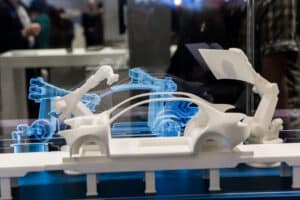
A critical aspect of using digital twins is that they can complement traditional forecasting and prescriptive tools by incorporating real-time monitoring and simulations.
Forecasting and planning in the automotive manufacturing industry has always been a challenge. Making matters worse is that 2023 is a year of transition for the market. Emerging from the pandemic, where sales plummeted, auto manufacturers face new challenges, including lingering supply chain issues and great uncertainties due to chip shortages and increasing global political unrest. This comes at a time when not only are the technologies and innovations rapidly advancing, but customer expectations are shifting quickly.
Increasingly, automakers are looking to smart manufacturing systems and specifically digital twins, to help overcome the uncertainties and ride out the unforeseen fluctuations that can impact production, demand, and more.
Smart auto manufacturing an auto manufacturer to plan, optimize, and test operations virtually before physically commissioning anything. Using a digital twin, a smart manufacturer can develop and try out work cells, manufacturing lines, and even an entire plant virtually. The data from this digital representation can be used to virtually identify obstacles, test solutions, and validate new scenarios.
A critical aspect of using digital twins is that they can complement traditional forecasting and prescriptive tools by using real-time monitoring. In particular, simulations using digital twins can reproduce dynamic behavior in a market and help predict its state in the future. Essentially simulations with digital twins make it possible to run virtual experiments to build more robust plans and resilient systems.
See also: Digital Twins, IT/OT Convergence Drive the Industrial Internet
Increasing resiliency in uncertain times
The use of digital twins to help prepare for and ride out uncertainties has been touted for years. A Digital Twin Consortium blog highlighted areas where digital twins could play such a role.
It noted: “The uncertainty and volatility require organizations to anticipate disruptions and reinforce the robustness of their action plans. Unfortunately, standard forecasting and planning tools do not empower them to achieve these goals.”
“Machine Learning/Deep Learning methods improve forecasting relatively well in stable environments with historical data. However, it quickly reaches its limits in the case of significant or profound structural changes. However, in digital twins, manufacturers finally have a new tool that can help them escape from production planning perils in an uncertain world.”
Among the ways digital twins can help includes stress testing plans to assess robustness. Traditional forecasting tools rely on simplified assumptions and neglect the impact of cascading effects. What’s needed is the ability to explore virtually an entire operation from end to end. An ideal system would allow a manufacturer to test different scenarios and simulate the step-by-step impact of any disruption across operations.
In that way, a manufacturer might see that a chip shortage could cascade into a production line shutdown. Once armed with such knowledge, a plan of action can be devised. That action might not be the most desirable, but at least the manufacturer could consider alternatives to minimize the problem.
Just looking at the impact of the chip shortage on the industry in the last few years shows why such forecasting is essential.
In 2021, the automotive industry lost more than $200 billion due to chip shortages. Eleven million fewer vehicles were produced. Manufacturing plants sat idle. Ford suspended operation at some plants to focus efforts on truck assembly, where the margins are better, according to an MIT Management, Sloan School article.
In 2022, many automakers decided to ship some of their most popular models without all the chips they were designed to include. For example, Automotive News reported that “Ford told its dealers it would start building Explorers, its best-selling SUV in the U.S., without the computer chips that enable rear-seat climate control, meaning that backseat passengers won’t be able to adjust the air conditioner and heat.” Thecompany said it would install the missing chips once they become available.
Shipping the cars without all of the chips is definitely not the best-case scenario. But it provided a way to keep sales going while the industry rode out the chip shortage.
Enabling simulations with digital twins
By running simulations of different scenarios, digital twins offer an accurate reflection of the current state versus the future state and can provide the insights needed for making decisions. Such capabilities are in high demand in automotive manufacturing, where unpredictable supply chain disruptions affecting materials, parts, and components availability lead to unexpected downtime.
Simulations with digital twins are part of a larger industry shift to smart manufacturing. If there is any doubt about the importance and benefits of smart manufacturing, one only needs to consider that it is among the technologies the U.S. has designated a critical emerging technology that will play an important role in the nation’s security.
While it may help the country, it can also help manufacturers better anticipate the impact of disruptions and allow them to formulate plans to deal with inevitable uncertainties as they emerge.
Additional Resources

Drive production excellence with intelligent manufacturing
The automotive industry is facing unprecedented challenges, with rapid change and intense pressure to meet the demands of climate change, regulations, and consumers. Download Now

Modernize automotive factories with Siemens Smart Manufacturing solutions
Discover how automakers can transform their business with Smart Manufacturing solutions using state-of-the-art hardware and software to modernize production lines. Watch Now

Virtual Manufacturing Development for the Automotive Industry
Companies in the automotive industry are pushing to develop the next generation of autonomous, electric, connected, and shared vehicles. View Now







